Students can access the CBSE Sample Papers for Class 12 Maths with Solutions and marking scheme Set 1 will help students in understanding the difficulty level of the exam.
CBSE Sample Papers for Class 12 Maths Set 1 with Solutions
Time Allowed: 3 hours
Maximum Marks: 70
General Instructions:
- This question paper contains five sections – A, B, C, D and E. Each section is compulsory. However, there are internal choices in some questions.
- Section – A has 18 MCQ’s and 02 Assertion-Reason based questions of 1 mark each.
- Section – B has 5 Very Short Answer (VSA)-type questions of 2 marks each.
- Section – C has 6 Short Answer (SA)-type questions of 3 marks each.
- Section – D has 4 Long Answer (LA)-type questions of 5 marks each.
- Section – E has 3 source based/case based/passage based/integrated units of assessment (4 marks each) with sub parts.
Section – A
(Multiple Choice Questions) Each question carries 1 mark

Question 2.
If A and B are invertible square matrices of the same order, then which of the following is not correct?
(a) adj A = |A|.A-1
(b) det (A)-1 = [det (A)]-1
(c) (AB)-1 = B-1.A-1
(d) (A + B)-1 = B-1 + A-1
Answer:
(d) (A + B)-1 = B-1 + A-1
Explanation:
If A and B are invertible square matrices, than all the other option are true related to it.
But (A + B)-1 ≠ B-1 + A-1
Question 3.
If the area of the triangle with vertices (- 3, 0), (3, 0) and (0, k) is 9 sq. units, then the value/s of k will be:
(a) 9
(b) ±3
(c) -9
(d) 6
Answer:
(b) ± 3

Question 4.

(a) – 3
(b) 0
(c) 3
(d) any real number
Answer:
(a) -3
Explanation:

Question 5.
The lines
\(\vec{r}=\hat{i}+\hat{j}-\hat{k}+\lambda(2 \hat{i}+3 \hat{j}-6 \hat{k})\) and \(\vec{r}=2 \hat{i}-\hat{j}-\hat{k}+\mu(6 \hat{i}+9 \hat{j}-18 \hat{k})\); (where λ and μ are scalars) are:
(a) coincident
(b) skew
(c) intersecting
(d) parallel
Answer:
(d) parallel
Explanation:
Here, equation of lines are
\(\vec{r}=\hat{i}+\hat{j}-\hat{k}+\lambda(2 \hat{i}+3 \hat{j}-6 \hat{k})\) and \(\vec{r}=2 \hat{i}-\hat{j}-\hat{k}+\mu(6 \hat{i}+9 \hat{j}-18 \hat{k})\)
Equations of line in Cartesian form:

Here, direction ratios equations (i) and (ii) are parallel. Therefore, given eqaution of lines are parallel.
Question 6.
The degree of the differential equation \(\left[1+\left(\frac{d y}{d x}\right)^2\right]\) = \(\left(\frac{d^2 y}{d x^2}\right)^2\)
(a) 4
(b) \(\frac{3}{2}\)
(c) 2
(d) Not defined
Answer:
(c) 2
Explanation:
The given differential equation is:
\(\left[1+\left(\frac{d y}{d x}\right)^2\right]^3=\left(\frac{d^2 y}{d x^2}\right)^2\)
So, here degree of given differential equation is 2.
Question 7.
The comer points of the bounded feasible region determined by a system of linear constraints are (0, 3), (1,1) and (3,0). Let Z = px + qy, where p, q > 0. The condition on p and q so that the minimum of Z occurs at (3, 0) and (1,1) is:
(a) p = 2p
(b) p = \(\frac{q}{2}\)
(c) p = 3q
(d) p = q
Answer:
(b) p = \(\frac{q}{2}\)
Explanation:
Given, Z = px + qy
Given minimum of Z occurs at (3, 0) and (1,1)
∴ 3p = p + q
⇒ 2p = q
p = \(\frac{q}{2}\)
Question 8.
ABCD is a rhombus whose diagonals intersect at E. Then \(\overrightarrow{\mathrm{EA}}+\overrightarrow{\mathrm{EB}}+\overrightarrow{\mathrm{EC}}+\overrightarrow{\mathrm{ED}}\) is equal to:
(a) \(\overrightarrow{0}\)
(b)\(\overrightarrow{\mathrm{AD}}\)
(c) 2 \(\overrightarrow{\mathrm{BD}}\)
(d) \(\overrightarrow{0}\)
Answer:
(a) \(\overrightarrow{0}\)
Explanation:
In a rhombus diagonals bisect other at right angle.
Here, \(|\overrightarrow{\mathrm{EA}}|=|\overrightarrow{\mathrm{EC}}| \text { and }|\overrightarrow{\mathrm{EB}}|=|\overrightarrow{\mathrm{ED}}|\)
But their signs will be opposite

Question 9.
For any integer n, the value of \(\int_0^\pi e^{\sin ^2 x} \cos ^3(2 n+1) x d x\) is:
(a) -1
(b) 0
(c) 1
(d) 2
Answer:
(b) 0
Explanation:
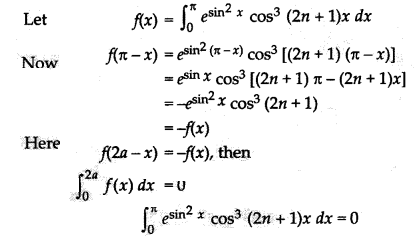
Question 10.
The value of |A|, if A =  , where x ∈ R+, is:
, where x ∈ R+, is:
(a) (2x + 1)2
(b) 0
(c) (2x + 1)3
(d) (2x – 1)2
Explanation:

∴ A is a skew-symmetric matrix of order 3.
Hence, by property of skew-symmetric matrix |A| = 0.
Question 11.
The feasible region corresponding to the linear constraints of a Linear Programming Problem is given below:

Which of the following is not a constraint to the given Linear Programming Problem?
(a) x + y > 2
(b) x + 2y < 10
(c) x – y > 1
(d) x – y < 1
Answer:
(c) x — y > 1
Explanation:
For inequality x – y > 2, condition of origin (0, 0) is not satesfied. So it is away from origin, and true according to the given graph.
For option (b); (0,0) satisfy the inequality and shaded region is towards the origin. So, it is correct. For option (c); (0,0) does not satisfy the inequality x – y > 1. but shaded region is towards the origin. So, this inequality is incorrect.
Question 12.
If \vec{a}=4 \(\hat{i}+6 \hat{j}\) and \(\vec{b}=3 \hat{j}+4 \hat{k}\) then the vector
form of the component of \(\vec{a}\) along \(\vec{b}\) is:
(a) \(\frac{18}{5}(3 \hat{i}+4 \hat{k})\)
(b) \(\frac{18}{25}(3 \hat{j}+4 \hat{k}\)
(c) \(\frac{18}{5}(3 \hat{i}+4 \hat{k}\)
(d) \(\frac{18}{25}(2 \hat{i}+4 \hat{j})\hat{k}\)
Answer:
(b) \(\frac{18}{25}(3 \hat{j}+4 \hat{k}\)
Explanation:

Question 13.
Given that A is a square matrix of order 3 and |A| = – 2, then |adj(2A)| is equal to:
(a) -26
(b) 4
(c) – 28
(d) 28
Answer:
(d) 28
Explanation:
Given |A| = -2
Now
As matrix A is of order 3
∴ |adj(2A)| = (23|A|)2
= 26|A|2
= 26(-2)2
= 28
Question 14.
A problem in Mathematics is given to three students whose chances of solving it are \(\frac{1}{2}, \frac{1}{3}, \frac{1}{4}\) respectively.
If the events of their solving the problem are independent then the probability that the problem will be solved is:
(a)\(\frac{1}{4}\)
(b)\(\frac{1}{3}\)
(c)\(\frac{1}{2}\)
(d)\(\frac{3}{4}\)
Answer:
(d)\(\frac{3}{4}\)
Explanation:
Let A,B and C be the respectively events of solving the problem by three students.
Here, P(A) = \(\frac{1}{2}\), P(B) = \(\frac{1}{3}\), P(C) = \(\frac{1}{3}\)
Then, P(\overline{\mathrm{A}}) = \(\frac{1}{2}\), P(\overline{\mathrm
Here A, B, C are independent events.
Then, the problem will solved if atleast one will solve it.

Question 15.
The general solution of the differential equation ydx – xdy = 0; (Given x,y > 0), is of the form:
(a) xy = c
(b) x = cy2
(c) y = cx
(d) y = cx2
Answer:
y = cx
Explanation:

where, c is the constant of integration ⇒ log y = log (cx)
y = cx, is the required general solution of the equation.
Question 16.
The value of X for which two vectors \(2\hat{i}-\hat{j}+2 \hat{k}\) and \(3\hat{i}+\lambda \hat{j}+\hat{k}\) are perpendicular is:
(a) 2
(b) 4
(c) 6
(d) 8
Answer:
(d) 8
Explanation:
The vectors \(2\hat{i}-\hat{j}+2 \hat{k}\) and \(3\hat{i}+\lambda \hat{j}+\hat{k}\) are perpendicular to each other. Then, their dot product will be zero.
∴ \(2\hat{i}-\hat{j}+2 \hat{k}\).\(3\hat{i}+\lambda \hat{j}+\hat{k}\) = 0
⇒ 6 – λ + 2 = 0
⇒ 8 – λ = 0
⇒ λ = 8
Question 17.
The set of all points where the function f(x) = x + |x| is differentiable, is:
(a) (0, ∞)
(b) (- ∞, 0)
(c) (- ∞, 0) ∪ (0, ∞)
(d) (- ∞, ∞)
Answer:
(c) (- ∞, 0) ∪ (0, ∞)
Explanation:
f(x) = x + |x|

L f(0) = 0 and Rf(0) = 2
For x > 0, f(x) = 2x (linear function)
For x < 0, f(x) = 0 (constant function)
Hence, f(x) is differentiable when xe (- ∞,0)∪(0, ∞)
Question 18.
If the direction cosines of a line are \(\left\langle\frac{1}{c}, \frac{1}{c}, \frac{1}{c}\right\rangle\) then
(a) O < c < 1
(b) c < 2
(c) c < 2 ± √2
(d) c = ±√3
Answer:
(d) c = ±√3
Explanation:
For any lind d.c’s are

Question 19.
Let f(x) be a polynomial function of degree 6 such that \(\frac{d}{d x}\)(f(x)) = (x – 1)3 (x – 3)2, then
Assertion (A):f(x) has a minimum at x = 1.
Reason (R): When\(\frac{d}{d x}\)(fx)) < 0, ∀ x ∈ (a – h, a) and \(\frac{d}{d x}\)(f(x)) > 0, ∀ x el (a, a + h); where ‘h’ is an .
infinitesimally small positive quantity, then/(x) has a minimum at x = a, provided fix) is continuous at x = a.
Answer:
(a) Both (A) and (R) are true and (R) is the correct explanation of (A).
Explanation:
Given:
\(\frac{d}{d x}\)(f(x)) = (x – 1)3 (x – 3)2
\(\frac{d}{d x}\)(f(x))< 0, ∀ x ∈ ( 1 – h, 1) \(\frac{d}{d x}\)(f(x))> 0, ∀ x ∈ (1, 1 + h)
Where, h is a small positive quantity. So, f(x) has a minimum at x = 1.
Question 20.
Assertion (A): The relation f : {1, 2, 3, 4} → {x, y, z, p] defined by f = {(1, x), (2, y), (3, z)} is a bijective function.
Reason (R): The function f: {1, 2, 3} → {x, y, z, p\ such that/= {(1, x), (2, y), (3, z)} is one-one.
Answer:
(d) (A) is false but (R) is true.
Explanation:
In the assertion, the given relation is not a objective function. As element 4 has no image under f. So, assertion is false. The function given in reason is one-one because for each element there is a different image under f.
Hence, reason is true.
∴ A is false, R is true.
Section – B
[This section comprises of very short answer (VSA) type-questions of 2 marks each]
Question 21.
Find the value of sin \(\left[\cos \left(\frac{33 \pi}{5}\right)\right]\)
Or
Find the domain of sin-1 (x2 – 4).
Answer:

⇒ x ∈ [-√5, √-3] ∪ [√3,√5]
Required domain is [-√5, -√3 ] ∪ [√3, √5].
Question 22.
Find the interval/s in which the function f : R → R defined by f(x) = xex, is increasing.
Answer:
Given: f(x) = xex
on differentiating both sides
f'(x) = ex + xex
= ex (1- x)
For f(x) to increasing
f'(x) ≥ 0
ex(l + x) ≥ 0
⇒ 1 + x > 0 as ex 0 ∀ x ∈ R
⇒ x ≥ -l
Required interval is [-1, ∞].
Question 23.
If f(x) = \(\frac{1}{4 x^2+2 x+1}\); x ∈ R then Find the maximum value of f(x).
OR
Find the maximum profit that a company can make, if the profit function is given by P(x) = 72 + 42x – x2, where x is the number of units and P is the profit in rupees.
Answer:
F(x) = \(\frac{1}{4 x^2+2 x+1}\)
Let g(x) = 4x2 + 2x + 1
Now, g(x) = \(\frac{d}{d x}\)(4x2 + 2x + 1)
g'(x) = 8x + 2
For maxima or minima,
g'(x) = 0
8x + 2 = 0
x = \(-\frac{1}{4}\)
and g”(x) = 8 > 0
Hence, g(x) is minimum at x = –\(\frac{1}{4}\)
Now, since g(x) is minimum at x = –\(\frac{1}{4}\)
So, f(x) = \(\frac{1}{g(x)}\) is maximum at x = \(-\frac{1}{4}\)
and maximum value of

Or
Here, p(x) = 72 + 42x – x2
On differentiating both sides
P(x) = 42 – 2x
For finding maximum value, put
p'(x) = 0
42 – 2x = 0
42 = 2x
x = 21
Now, p”(x) = -2 < 0
So, P(x) is maximum at x = 21.
The maximum value of
P(x) = 72 + 42 x 21 – (21)2
= 72 + 882 – 441
= 954 – 441
= 513
Hence, the maximum profit is ₹513.
Question 24.
Evluate: \(\int_{-1}^1 \log _e\left(\frac{2-x}{2+x}\right) d x\)
Answer:

Question 25.
Check whether the function f: R → R defined by f(x) = x3 + x, has any critical point/s or not? If yes, then find the point/s.
Answer:
Given, f(x) = x3 + x, for all x ∈ R
Differentiate both sides w.r.t. x,
∴ f'(x) = 3x2 + 1 for all x ∈ R
Now, x2 > 0
So, f(x)> 0
And by difinition, a point (c,f(c)) is a critical point of a continuous function f(x) if and only if f'(c) = 0 or f(c) is not defined.
This condition does not exist. So, critical points does not exist in this situation.
Section – C
[This section comprises of short answer (SA) type questions of 3 marks each]
Question 26.
Evluate: \(\int \frac{2 x^2+3}{x^2\left(x^2+9\right)}\) dx; x ≠ 0
Answer:

Question 27.
The random variable X has a probability distribution P(X) of the following form, where ‘k is some real number.
\(\mathrm{P}(\mathrm{X})=\left\{\begin{array}{l}
k, \text { if } x=0 \\
2 k, \text { if } x=1 \\
3 k, \text { if } x=2 \\
0, \text { otherwise }
\end{array}\right.\)
(i) Determine the value of k.
(ii) Find P(X < 2). (iii) Find P(X > 2).
Answer:
(i)Here, p(0) = k
p(1) = 2k
p(2) = 3(k)
Now, Σp(Xi) = 1
∴ p(0) + p(1) + p(2) = 1
⇒ k + 2k + 3k = 1
⇒ 6k = 1
⇒ k = \(\frac{1}{6}\)
(ii) P(X < 2) = P(X = 0) + P(X = 1) = k + 2K = \(\frac{1}{6}\) + 2 × \(\frac{1}{6}\) = \(\frac{1}{6}\) + \(\frac{2}{6}\) = \(\frac{3}{6}\) = \(\frac{1}{2}\) (iii) P(X > 2) = 0 (as anything greater than 2 is 0)
Question 28.
Evluate \(\int \sqrt{\frac{x}{1-x^3}}\)dx; x ∈ (0, 1)
Or
Evluate : \(\int_0^{\pi / 4}\)loge(1 + tan x) dx.
Answer:

where ‘C’ is an arbitaray constant of integration.
Or
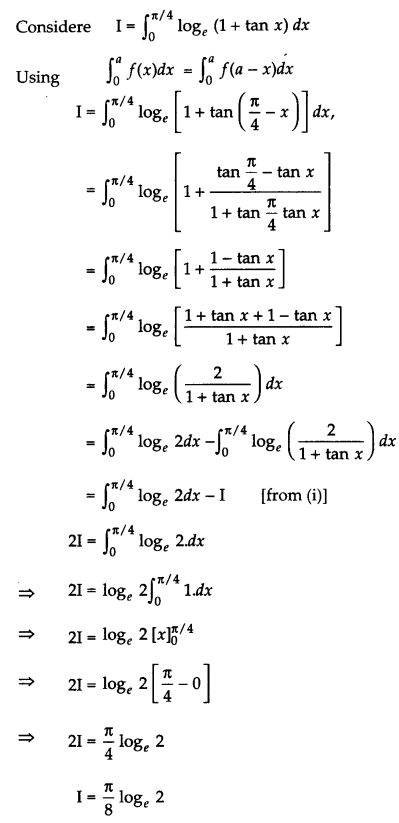
Question 29.
Solve the differential equation: yex/y dx = (xex/y +y2)dy (y ≠ 0).
or
Solve the differential equation: (cos2x)\(\frac{d y}{d x}\) + y = tan x;
Answer:
Given differential equation is:
yex/y dx = (xex/y + Y2)dy
⇒ \(\frac{d x}{d y}\) = \(\frac{x e^{x / y}+y^2}{y e^{x / y}}\)
= \(\frac{x}{y}+\frac{y}{e^{x / y}}\)
The given eqaution is homogeneous
Let x = vy
⇒ \(\frac{d x}{d y}\) = v + y\(\frac{d v}{d y}\)
Put the value of \(\frac{d x}{d y}\) in (i), so equation (i) becomes

⇒ex/y = y + c is the required general solution of the diffirential equations.
Or
The given differential equation is

Question 30.
Solve the following Linear Programming problem graphically:
Minimize: Z = x + 2y,
Subject to the costraints, x + 2y ≥ 100, 2x – y ≤ 0, 2x + y ≤ 200,x,y ≥ 0.
Or
Solve the following Linear Programming Problem graphically:
Maximize: Z = – x + 2y,
Subject to the constraints, x ≥ 3, x + y ≥ 5, x + 2y ≥ 6, y ≥ 0.
Answer:
Given: Minimum. Z = x + 2y
Subject to constraints: x + 2y ≥ 100
2x – y ≤ 0
2x + y ≤ 200
Changing inequalities to equalities, we get
x + 2y = 100
| x | 0 | 100 |
| y | 50 | 0 |
2x – y = 0
| x | 0 | 50 |
| y | 0 | 100 |
2x + y = 20
| x | 100 | 50 |
| y | 0 | 100 |
On plotting these points on graph, we get

Here, x + 2y ≥ 100, does not satesfy the condition of origin (0, 0), so shaded area is away from the origin. Equation 2x + y ≥ 200, satisfy the condition of (0, 0), so shaded area is towards the origin.
| Comer points | Corresponding value of Z = x + 2y |
| A(0, 50) | 100 (Minimum) |
| B(20, 40) | 100 (Minimum) |
| C(50, 100) | 250 |
| D(0, 200) | 400 |
The minimum value of Z is 100 at all the points on the line segment joining the points (0,50) and (20,40).
Or
Given, maximum Z = – x + 2y
Subject to constraints:
x ≥ 3
x + y ≥ 5
x + 2y ≥ 6
y ≥ 0
Changing inequations to equations, we get x = 3
x + y = 5
| x | 0 | 5 |
| y | 5 | 0 |
x + 2y = 6
| x | 0 | 6 |
| y | 3 | 0 |
Plotting these equations on graph, we get

Here, inequations x ≥ 3, x + y ≥ 5, x + 2y ≥ 6 does not satisfy the condition of origin (0, 0), so shaded area is away from the origin. So, the feasible region is unbounded. The values of Z at comer point are:
| Corner point are | Z = -x + 2y |
| A(3, 2) | 1 Max. |
| 6(4, 1) | -2 |
| C(6, 0) | -6 |
Since, the feasible region is unbounded. So we draw the inequality -x + 2y > 1.
Now, we will check whether the reusltion open haif has any point(s) in common with the feasible region oe not.
Here, resultion open half has points in common with its flasible region.
Hence,Z = 1 is not the maximum value or Z has no maximum value.
Question 31.
IF (a + bx)ey/x = x then prove that x \(\frac{d^2 y}{d x^2}\) = \(\left(\frac{a}{a+b x}\right)\)
Answer:
Given:
(a + bx)ey/x = x
Taking log on both sides,
log [(a + bx)ey/x = log x
⇒ log (a + bx) + log ey/x = log x
⇒ \(\frac{y}{x}\) = log x – log (a + bx)
On differentiating w.r.t.x, we get
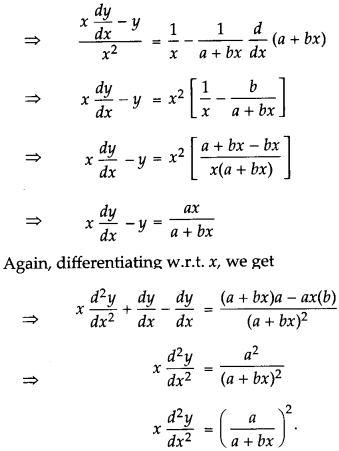
Section – D
(This section comprises of long answer (LA) type questions of 5 marks each)
Question 32.
Make a rough sketch of the region (x, y) : [0 ≤ y ≤ x2 + 1, 0 ≤ y ≤ x + 1, 0 ≤ x ≤ 2] and find the area of the region, using the method of integration.
Answer:
According to the question, the equations given are:
x2 + 1 = y
x + 1 = y
and x = 2
On solving equations (i) and (ii) to find the point of intersection.
∴ x2 + 1 = x + 1
x2 = x
⇒ x2 – x = 0
⇒ x(x -1) = 0
⇒ x = 0,1
Then, y = 1, 2
Hence, parabola and line intersect at point (0,1) and (1, 2).

Area of shaded region OPQRSTO = Area of region OTQPO + Area of region TSRQT
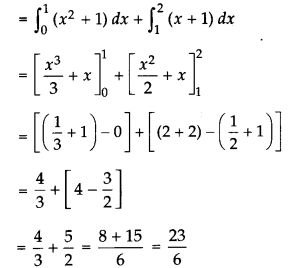
Hence, the required area is \(\frac{23}{6}\)sq. units.
Question 33.
Let N be the set of all natural numbers and R be a relation on N × N defined by (a, b) R(c, d) ⇔ ad = be for all (a, b), (c, d) e N × N. Show that R is an equivalence relation on N × N. Also, find the equivalence class of (2, 6), i.e., [(2, 6)].
OR
Show that the function f : R → {x ∈ R : -1 < x < 1} defined f(x) = \(\frac{x}{1+|x|}\)
x ∈ R is one-one and onto function.
Answer:
Consider (a, b) an arbitrary element of N × N. Then, (a, b) ∈ N × N and a,b ∈ N.
Consider (a, b) an arbitrary element of N × N. Then, (a, b) ∈ N × N and A/EN.
We have (As multiplication is commutative on N)
∴ (a, b) R (a, b), according to the definition of the relation R on N × N.
Thus, (a, b) R(a, b), ∀ (a, b) ∈ N × N
So, R is reflexive relation on N × N.
Symmetric: Consider (a, b), (c, d) be arbitrary elements of N × N such that (a, b) R(c, d).
Then, (a, b) R(c, d) ⇒ ad = be ⇒ be-ad;
⇒ cb = da, (Multiplication is commutative on N)
⇒ (c,d) R(a,b), by definition of the relation on N × N.
∴ (a, b) R(c, d) = (c, d) R(a, b)
So, R is symmetric relation onN × N.
Transitive: Let (a, b) (c, d) (e,f) be arbitrary elements of N × N such that
Than, (a, b) R(c, d) ⇒ ad = be …(i)
Than, (c, d)R(e,f) ⇒ cf= de …(ii)
From (i) and (ii),
(ad) (cf) = (bc) (de) ⇒ af = eb
By definition of the relation R on N × N.
∴ (a, b) R(e,f)
Thus (a, b) R(c, d) and (c, d) R(e,f) ⇒ (a, b) R(e,f)
So, R is transitive relationon N × N.
Now, the relation R is reflexive, symmetric and transitive, so it is an equivalence relation on N × N. Equivalence class,
[(2, 6)] = {(x, y) ∈ N × N : (x, y) R(2, 6)}
= {(x, y) ∈ N × N : 3x = y}
= {(x, 3x) : x ∈ N)
= {(1,3), (2, 6), (3, 9),…}.
Given, Function is f(x) = \(\frac{x}{1+|x|}\), x ∈ R
We have, f(x)= \(\begin{cases}\frac{x}{1+x}, & \text { if } x \geq 0 \\ \frac{x}{1-x}, & \text { if } x<0\end{cases}\)
Case 1: When x ≥ 0
One-one (Injectivity):
Let x, y ∈ R+ ∪{0}
such that f(x) = f(y), then
\(\frac{x}{1+x}=\frac{y}{1+y}\)
⇒ x + xy = y + xy
⇒ x = y
So,f(x) is one-one. Onto (Surjectivity):
Let y ∈ [0, 1] thus for each y ∈ [0, 10) there exist x = \(\frac{y}{1-y}\)>0 such that
\(f(x)=\frac{\frac{y}{1-y}}{1+\frac{y}{1-y}}=y\)
So, f is anto function on [0, ∞] to [0,1]
Case 2: When x < 0
One-One (Injectivity):
Let x,y ∈ R–i.e., x,y < 0, such that f(x) = f(y),
∴ \(\frac{x}{1-x}=\frac{y}{1-y}\)
⇒ x – xy = y – xy
⇒ x = y
So, f(x) is one-one function
Onto (Surjectivity): Let y e (-1, 0) be an arbitrary real number and there exist x = \(\frac{y}{1+y}\) < 0, such that

So for y ∈ (-1, 0) there exists x = \(\frac{y}{1+y}\)< 0 such that
f(x) = y
Hence, f is onto function on (-∞, 0) to (-1, 0)
Hence, f(x) is one-one and into function.
Question 34.
Using the matrix method, solve the following system of linear equations:
\(\frac{2}{x}+\frac{3}{y}+\frac{10}{z}\) = 4,\(\frac{4}{x}-\frac{6}{y}+\frac{5}{z}\) = 1,
\(\frac{6}{x}+\frac{9}{y}-\frac{20}{z}\) = 2.
Answer:
The given system of equations are
\(\frac{2}{x}+\frac{3}{y}+\frac{10}{z}\) = 4
\(\frac{4}{x}-\frac{6}{y}+\frac{5}{z}\) = 1
\(\frac{6}{x}+\frac{9}{y}-\frac{20}{z}\) = 2
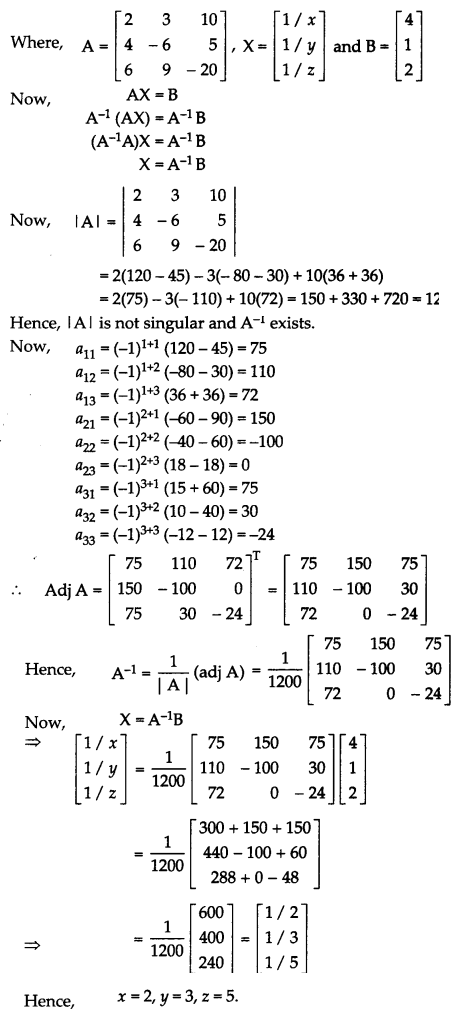
Question 35.
Find the coordinates of the image of the point (1,6,3) with respect to the line \(\vec{r}=(\hat{j}+2 \hat{k})+\lambda(\hat{i}+2 \hat{j}+3 \hat{k})\) where ‘λ’ is a scalar. Also, find the distance of the image from the Y-axis.
Or
An aeroplane is flying along tire line \(\vec{r}=\lambda(\hat{i}-\hat{j}+\hat{k})\)where ‘X’ is a scalar and another aeroplane is flying along the line \(\vec{r}=\hat{i}-\hat{j}+\mu(-2 \hat{j}+\hat{k})\) where ‘\x is a scalar. At what points on the line should they reach, so that the distance between them is the shortest. Find the shortest possible distance between them.
Answer:
Here, P(1,6,3) is the poin whose image is to be found in the line AB.
L is the foot of perpendicular on the given line. And point Q(x1,y1 Z1) is the image of point P.

Now, eqaution of line is,
\(\vec{r}=(\hat{j}+2 \hat{k})+\lambda(\hat{i}+2 \hat{j}+3 \hat{k})\)
Now, equation of line is,
Equation is Cartesian form is,
∴ \(\frac{x-0}{1}=\frac{y-1}{2}=\frac{z-2}{3}\) = λ;
where λ is any scalar.
∴ x = λ, y = 2λ + 1 and 3λ + 2.
Let the coordinates of l be ( λ, 2λ + 1, 3λ + 2).
So, the direction ratios of PL are λ -1, 2λ + 1 – 6 and 3λ + 2 – 3, i.e., λ – 1, 2λ – 5 and 3λ – 1. And the direction ratios of the line perpendicular PL is 1, 2, 3.
∴ (λ – 1) × 1 + (2λ – 5) × 2 + (3λ – 1) × 3 = 0
λ – 1 + 4λ – 10 + 9λ – 3 = 0
⇒ 14λ – 14 = 0
⇒ λ = 1
∴ Coordinates of L are (1,2 × 1 + 1, 3 × l + 2) i.e., (1,3, 5)
L is the mid-point of line PQ and coordinates of Q(x1, y1, z1)
∴ \(\frac{\left(x_1+1\right)}{2}\) = 1 ⇒ x1 = 1
\(\frac{\left(y_1+6\right)}{2}\) = 3 ⇒ y1 = 0
\(\frac{\left(y_1+6\right)}{2}\) = 5 ⇒ z1 = 7
Coordinates of Q(1,0,7)
Distance of point Q(1,0,7) Form Y-axis \(\sqrt{1^2+7^2}\) = \(\sqrt{1+49}\) = √50 unit
Hence, image of point p(1,6,3) is Q(1,0,7) and distance of image from y-axis is √50 unit.
Or
Equation of line in which first aeroplane is flying
\(\vec{r}=\lambda(\hat{i}-\hat{j}+\hat{k})\)
Then eqaution in Cartesian form is,
\(\frac{x-0}{1}\) = \(\frac{y-0}{-1}=\frac{z-0}{1}\)
\(\frac{x}{1}=\frac{y}{-1}=\frac{z}{1}\)
Second eqaution of line in which second aeroplane is flying
\(\vec{r}=\hat{i}-\hat{j}+\mu(-2 \hat{j}+\hat{k})\)
Then, equation in Cartesian form is,

Direction ratios are not proportional so lines are not parallel to each other. Let PQ be the perpendicular distance between the two lines coordinates of P be (λ, -λ, λ) coordinates of Q be (1, -2μ – 1, μ) where λ and μ are scalars.
Then direction ratios of line PQ are (λ -1, -λ + 2μ + 1, λ – μ)
Now, line PQ is perpendicular to lines (i) and (ii)
∴ 1(λ – 1) + (-1) (-λ + 2μ + 1) + (λ – μ) 1 = 0
⇒ λ – l + λ – 2μ – l + λ – μ = 0
⇒ 3λ – 3μ = 2
and 0(λ – 1) + (-λ + 2μ + 1) (-2) + (λ – μ)l = 0
2λ – 4μ – 2 + λ – μ = 0
3λ – 5μ = 2
On solving (iii) and (iv), we get
λ = \(\frac{2}{3}\) and μ = 0

This is the equired shortest distance between two lines.
Section – E
[This section comprises of 3 case-study/passage-based questions of 4 marks each with two sub-parts. The first two case study questions have three sub-parts (i), (ii), (iii) of marks 1,1, 2 respectively. The third case study question has two sub-parts of 2 marks each.]
Question 36.
Read the following passage and answer the questions given below:
In an Office three employees James, Sophia and Oliver process incoming copies of a cerfun form. James processes 50% of the forms, Sophia processes 20% and Oliver the remaining 30% of the forms. James has an error rate of 0.06, Sophia has an error rate of 0.04 and Oliver has an error rate of 0.03. Based on the above information, answer the following questions.
(i) Find the probability that Sophia processed the form and committed an error.
(ii) Find the total probability of committing an error in processing the form.
(iii) The manager of the Company wants to do a quality check. During inspection, he selects a form at random from the days output of processed form. If the form selected at random has an error, find the probability that the form is not processed by James.
OR
(iii) Let E be the event of committing an error in processing the form and let E1, E2 and E3 be the events that James, Sophia and Oliver processed the form. Find the value of \(\sum_{i=1}^3 \mathrm{P}\left(\mathrm{E}_i \mid \mathrm{E}\right)\)
Answer:
Let E1, E2 and E3 be the events that James, Sophia and Oliver processed the form.
Here, E1, E2 and E3 are mutually exclusive events.
Let, E be the event of comitting an error.
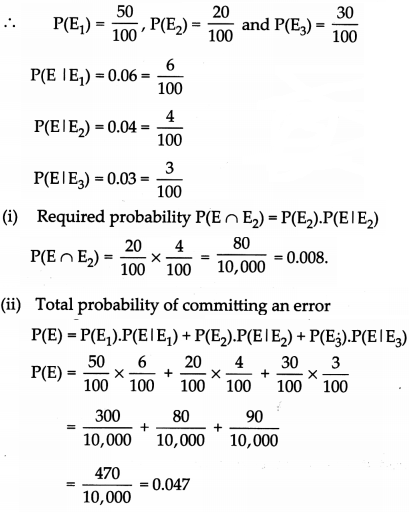
(iii) The probability that the form processed by James has an error is given by Bayes’ theorem:
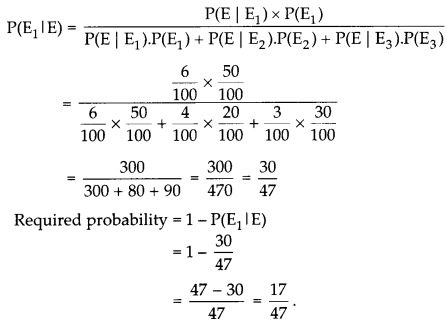
Or
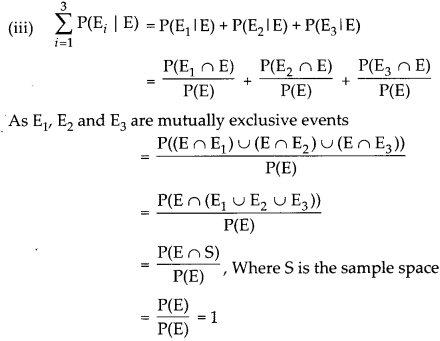
Question 37.
Read the following passage and answer the questions given below:
Teams A, B, C went for playing a tug of war game. Teams A, B, C have attached a rope to a metal ring and is trying to pull the ring into their own area.
Team A pull with force F1 = \(6 \hat{i}+0 \hat{j} k \mathrm{~N}\)
Team B pulls with force F2 = \(-4 \hat{i}+4 \hat{j} k \mathrm{~N}\)
Team C pulls with force F3 = \(-3 \hat{i}-3 \hat{j} k \mathrm{~N}\)

(i) What is the magnitude of the force of Team A?
(ii) Which team will win the game?
(iii) Find the magnitude of the resultant force exerted by the teams.
OR
(iii) In what direction is the ring getting pulled?
Answer:
Here, F1 = \(6 \hat{i}+0 \hat{j} k \mathrm{~N}\)
F2 = \(-4 \hat{i}+4 \hat{j} k \mathrm{~N}\)
F3 = \(-3 \hat{i}-3 \hat{j} k \mathrm{~N}\)
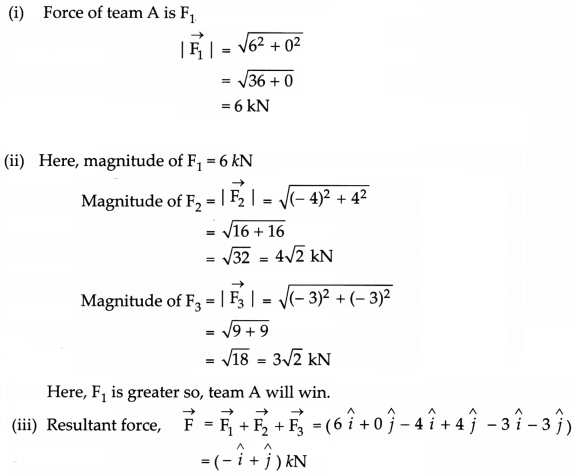
Or
(iii) Here, resultant force of team A is greater. So, ring will be pulled in the direction of A i.e., positive direction of X-axis.
Question 38.
Read the following passage and answer the questions given below:
The relation between the height of the plant (‘y’ in cm) with respect to its exposure to the sunlight is governed by the following equation
y = 4x – \(\frac{1}{2}\) x2, where ‘x’ is the number of days exposed to the sunlight, for
x ≤ 3.
(i) Find the rate of growth of the plant with respect to the number of days exposed to the sunlight.
(ii) Does the rate of growth of the plant increase or decrease in the first three days? What will be the height of the plant after 2 days?
Answer:
Here, y = 4x – \(\frac{1}{2}\) x2
(i) For finding the growth rate, differentiate y w.r.t. x
\frac{d y}{d x} = 4 – \(\frac{1}{2}\) × 2x
= 4 – x
(ii) Here f(x) = \( \frac{d y}{d x}\) = 4 – x (growth rate of plant)
f'(x) = \(\frac{d^2 y}{d x^2}\) = -1 < 0
Hence, growth rate of plant decreases for first three days. Height of plant after 2 days is
y = 4 × 2 – \(\frac{1}{2}\)(2)2
= 8 – 2 = 6 cm.